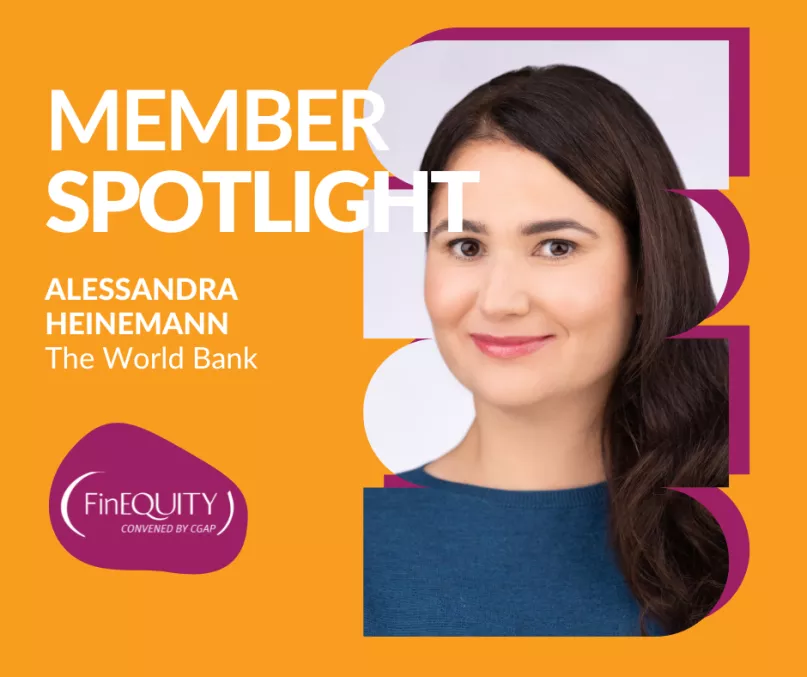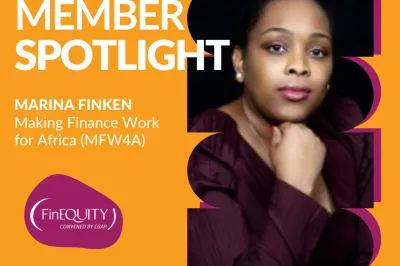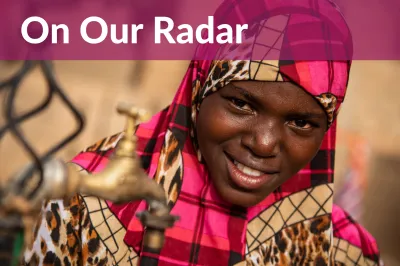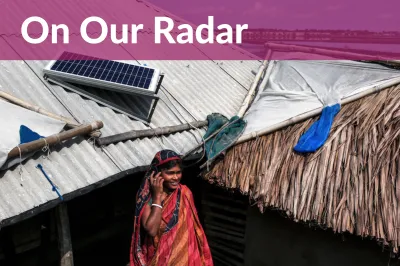Member Spotlight: Alessandra Heinemann

Alessandra Heinemann, Senior Social Protection Specialist at The World Bank, sat down with us to discuss the connection between social protection programs and mitigating gender-based violence, how digital cash transfers are empowering women, and the launch of a new e-learning course that can be used by the FinEquity community.
FinEquity: Alessandra, can you tell us a little bit about yourself? A fun fact? Something that might surprise most people?
Heinemann: I’m German and Brazilian, and I think in some ways that really reflects who I am in the sense that I have what some might call a contradictory character. The beauty of working on international development is that you get to work with lots of people who have very interesting backgrounds and have lived in lots of different places – they are these mashups of lots of different influences. So, in that sense, I might be one of the typical development people who feels at home both everywhere and nowhere. And if you’re wondering if I’m a football/soccer talent, sadly I’m not!
FinEquity: How did you get involved in the social protection, gender, and economic inclusion spaces?
Heinemann: I started my career in social development at The World Bank and early on I worked on a couple of community-driven development projects, mostly in Haiti. This was in 2006 and social protection at the time was an emerging area for The World Bank. I think what really drew me to this sector is the rigor and now the wealth of impact evaluation that we have on cash transfers.
In a way, the story of cash transfers is sort of the story of unintended consequences. We continue to be surprised about the incredible knock-on-effects that giving cash to people has. Obviously, there is now a huge literature on a whole range of human capital outcomes – in terms of health, education, nutrition, people’s savings behavior, their resilience and mental well-being, and increasingly, gender-based violence too. I find it really striking that programs that have not been designed with violence prevention in mind at all end up having these really astounding impacts that are comparable to standalone violence prevention interventions. When you talk to laypeople and you tell them that giving people cash leads to all these amazing outcomes, they say, “well, yeah, of course it does!”. In some ways, these are the blind spots that we as development and policy people have and we feel like we need to see the impact evaluation before we believe it. So, I think it’s really the evidence and the rigor that drew me to this work.
“I find it really striking that programs that have not been designed with violence prevention in mind at all end up having these really astounding impacts that are comparable to standalone violence prevention interventions.”
FinEquity: You recently co-authored a World Bank report on gender-based violence and cash transfers. Do you want to share with us some of the key findings from this report?
Heinemann: The report really builds on the amazing work that the research community has done on this topic over the last decade or so. It covers a very exciting growing body of evidence that finds cash transfers reduce violence against women and children, even when the cash transfer was not designed with violence prevention in mind. We now have impact evaluation evidence across a fairly wide range of contexts that has solidified this overall evidence pattern and there is a lot more research in the works that is very exciting. What I tell my social protection colleagues is that, chances are, safety net projects are already reducing gender-based violence (GBV) even without us really trying. So, given the reach and scale of safety nets around the world, especially post-COVID, we should try to exploit this more systematically.
I have been describing the Safety First report as a cookbook – the idea is that you shouldn’t have to read it from cover to cover, but that it is a manual organized around what we call the social protection delivery chain. This includes the project cycle from communicating about your program and enrolling your participants, all the way to managing the program and any grievances. For each stage of the social protection delivery chain, the report gives you very concrete design and implementation tweaks that you can take that will hopefully amplify the protective potential of your social safety net project and mitigate against risks of GBV and sexual exploitation and abuse.
The report draws on qualitative work and case studies that colleagues of mine have done in various corners of the world, as well as on the impact evaluation evidence. My hope is that it is a very practical tool that becomes a reference people can come back to at various stages in the design and implementation of their program for inspiration in terms of what they might be able to add and improve as they go along.
FinEquity: Can financial inclusion play a role in reducing the risk of gender-based violence? If so, how?
Heinemann: We already know that getting cash into women’s hands, ideally through their own bank account, is a really important aspect of empowering women economically. But in certain contexts, that also comes with potential risks, especially risks of backlash in more conservative contexts. One question that has gotten a lot of attention lately is the digitization aspect, as an increasing number of cash transfers are being paid out digitally into women’s bank accounts. This is great news in terms of women being able to have a gateway to other digital services and information. The evidence that we have confirms that digital payments in a lot of places are obviously more efficient, more user-friendly and, interestingly, this also has implications for gender-based violence within households.
But, of course, this is very context dependent. Where women lack digital literacy or when they don’t have their own phones, digital payments have their drawbacks in terms of women being able to retain control and influence over how the cash is spent. One really important aspect as we move towards paying cash transfers digitally is for us to think about how we make sure that we continue to deliver what we call “cash plus” elements in a way that is conducive to empowering women.
Traditionally when cash transfers have their payday, it serves as an opportunity for women to come together and for the program to deliver other information services in addition to the cash. It’s often also an opportunity for women to attend training sessions and to build social capital by interacting with other women and program providers. As we remove these in-person paydays and start paying digitally, we need to be really creative and thoughtful about how we maintain some of these cash plus elements and how we still find ways of delivering them in ways that work for the populations we are serving in different contexts. This may include online services or other kinds of in-person opportunities for people to interact with each other, learn and access training. It’s a bit of a shift in terms of how some programs are operating that needs to be thought through.
“Paying benefits directly to women, into their own accounts, can help them retain greater control over resources, and evidence suggests that it can also potentially help them conceal the payment from violent partners.”
FinEquity: Have you seen any examples of these cash plus elements in practice that are working to complement digital cash transfers?
During COVID, a lot of programs have had to pivot very quickly without the luxury of doing a lot of qualitative work to make sure that the pivot is working as well as one wants it to work. Especially pre-vaccine, we had to take physical distancing measures very seriously to make sure we weren’t putting anyone at increased risk. There were very creative examples of how people have found workarounds.
For example, a program in Peru had a parenting component where a community worker would visit households and provide information on hygiene and feeding practices, and they very organically shifted to organizing people into WhatsApp groups where they were able to continue checking in with each other. We talk a lot about adaptive social protection systems that should help people cope with shocks very quickly, and I think that COVID was a test case for a number of interesting ideas that had to be implemented on the fly. As the world is normalizing, there is a lot to be done in terms of going back to places and extracting some of these lessons and experiences to feed them back into systems so that we are more prepared for future crises.
FinEquity: Can you tell us about the newly launched training on social protection and gender-based violence? In what ways could this training be useful for people working in the financial inclusion space?
Heinemann: There was a lot of demand for training on the toolkit itself, so we thought we should turn this into an e-learning course, which we launched during the 16 Days of Activism Against Gender-Based Violence in November of last year. This is now available to anyone on The World Bank’s Open Learning catalog, whether they are working inside or outside of The World Bank. The course as a whole is pitched at a general audience – you don’t necessarily need any kind of pre-existing GBV expertise or gender and social protection expertise. It is an introductory course that should take somewhere between 80 and 90 minutes to complete.
The course takes the social protection delivery chain as its organization principle in the same way that the toolkit does. It starts with a summary of the evidence on cash transfers and gender-based violence, and then it takes a very systematic approach across the delivery chain. For each section, it highlights opportunities, risks, and potential mitigation measures. Of course, there is no one-size-fits-all solution, so we have designed it in a way that we hope people will walk away from the course being able to navigate trade-offs intelligently. There are a lot of decision trees for major design decisions throughout the course and it will walk you through a structured way of weighing opportunities and risks, and finding appropriate mitigation measures to deal with risks.
We also produced a number of videos for some of the major blocks of the course, which are available separately. If you don’t want to sit through the entire course and are pressed for time, you could watch the compilation of videos, which adds up to about 15 or 20 minutes.
FinEquity: Is there anything else you would like to share with the FinEquity community?
Heinemann: We hope that the community can use the videos and the e-learning course, and that they will let us know if there are any opportunities to collaborate in this space. If there are people working on interesting pilots or with lessons they would like to share, please do get in touch. There is a lot of innovation taking place and we would love to know how things are evolving in different contexts, and to help make this available to others.
You can access the new e-learning course on How to leverage safety nets to prevent-gender based violence here.
Watch the video on Social Protection Design Decisions: Are Payments Made Manually or Digitally?


